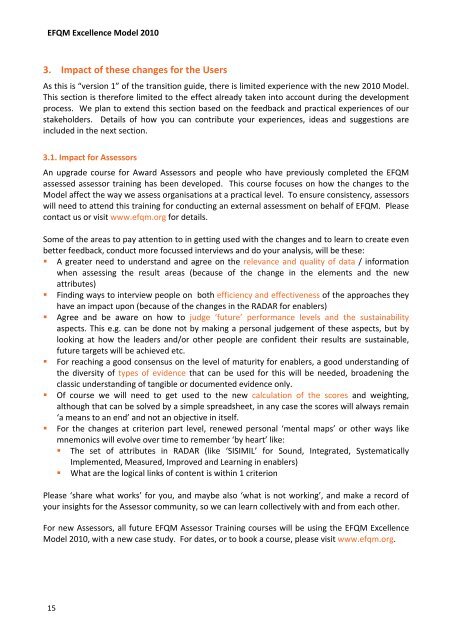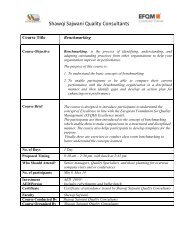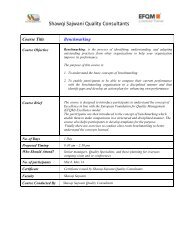EFQM Transition Guide - Shawqi Sajwani
EFQM Transition Guide - Shawqi Sajwani
EFQM Transition Guide - Shawqi Sajwani
Create successful ePaper yourself
Turn your PDF publications into a flip-book with our unique Google optimized e-Paper software.
<strong>EFQM</strong> Excellence Model 2010<br />
3. Impact of these changes for the Users<br />
As this is “version 1” of the transition guide, there is limited experience with the new 2010 Model.<br />
This section is therefore limited to the effect already taken into account during the development<br />
process. We plan to extend this section based on the feedback and practical experiences of our<br />
stakeholders. Details of how you can contribute your experiences, ideas and suggestions are<br />
included in the next section.<br />
3.1. Impact for Assessors<br />
An upgrade course for Award Assessors and people who have previously completed the <strong>EFQM</strong><br />
assessed assessor training has been developed. This course focuses on how the changes to the<br />
Model affect the way we assess organisations at a practical level. To ensure consistency, assessors<br />
will need to attend this training for conducting an external assessment on behalf of <strong>EFQM</strong>. Please<br />
contact us or visit www.efqm.org for details.<br />
Some of the areas to pay attention to in getting used with the changes and to learn to create even<br />
better feedback, conduct more focussed interviews and do your analysis, will be these:<br />
• A greater need to understand and agree on the relevance and quality of data / information<br />
when assessing the result areas (because of the change in the elements and the new<br />
attributes)<br />
• Finding ways to interview people on both efficiency and effectiveness of the approaches they<br />
have an impact upon (because of the changes in the RADAR for enablers)<br />
• Agree and be aware on how to judge ‘future’ performance levels and the sustainability<br />
aspects. This e.g. can be done not by making a personal judgement of these aspects, but by<br />
looking at how the leaders and/or other people are confident their results are sustainable,<br />
future targets will be achieved etc.<br />
• For reaching a good consensus on the level of maturity for enablers, a good understanding of<br />
the diversity of types of evidence that can be used for this will be needed, broadening the<br />
classic understanding of tangible or documented evidence only.<br />
• Of course we will need to get used to the new calculation of the scores and weighting,<br />
although that can be solved by a simple spreadsheet, in any case the scores will always remain<br />
‘a means to an end’ and not an objective in itself.<br />
• For the changes at criterion part level, renewed personal ‘mental maps’ or other ways like<br />
mnemonics will evolve over time to remember ‘by heart’ like:<br />
• The set of attributes in RADAR (like ‘SISIMIL’ for Sound, Integrated, Systematically<br />
Implemented, Measured, Improved and Learning in enablers)<br />
• What are the logical links of content is within 1 criterion<br />
Please ‘share what works’ for you, and maybe also ‘what is not working’, and make a record of<br />
your insights for the Assessor community, so we can learn collectively with and from each other.<br />
For new Assessors, all future <strong>EFQM</strong> Assessor Training courses will be using the <strong>EFQM</strong> Excellence<br />
Model 2010, with a new case study. For dates, or to book a course, please visit www.efqm.org.<br />
15




